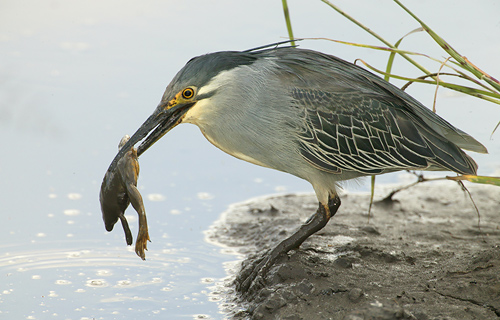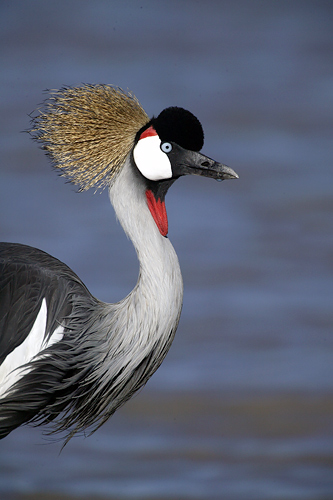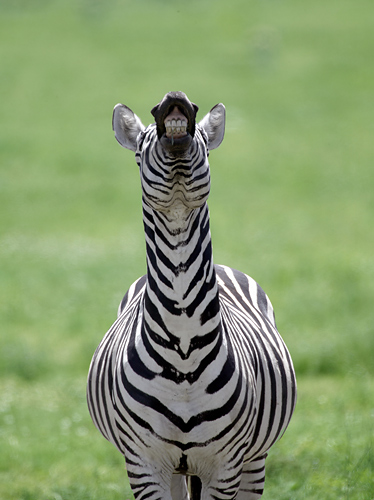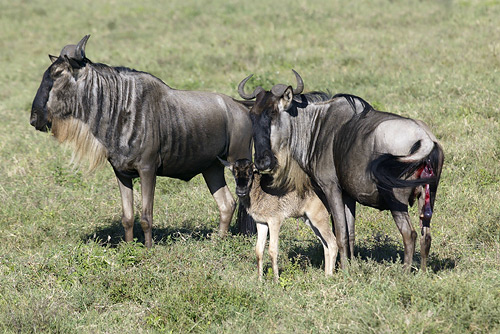|
BIRDS AS ART ON-LINE Bulletin #98 February 11,
2003
Tanzania Trip Report
2004 Gustafson/BIRDS AS ART Tanzania Photo Safari
Digital Adventures in Africa
ITP Updates
Lions with baby wildebeest,
Ngorongoro Crater
Digital capture with Canon
EOS 1D, 100-400MM l IS lens at 275mm
ISO 400. Evaluative Metering:
1/160 sec. at f/5.6 handheld
Image copyright 2003 Arthur
Morris/BIRDS AS ART
The handheld versatility of the 1-4 zoom is a
huge plus when photographing on safari.
TANZANIA TRIP REPORT
Our Tanzania
trip was incredibly successful. We had one or two slow mornings,
and an occasional slow afternoon, but all in all we had dozens of
incredible, heart-stopping photographic opportunities. Many of
you might remember that I was somewhat disappointed after my 1998
Kenya trip and vowed never to return to Africa. After this trip,
I am eager to get back and Todd Gustafson has already contacted
UTC/Leopard with our 2004 itinerary; see below for details. We
had four leopards, 7 or so cheetahs, and many, many
lions--including a baby female. We saw a leopard hunt and we saw a
cheetah hunt. We had one lion kill. At Ndutu we were in the
middle of a huge zebra and wildebeest migration, and, in addition,
the wildebeest were calving. Photographing at Ngorongoro Crater
is like photographing in a zoo, only the animals are all wild and
they eat each other! We had great chances on a variety of great
birds including Grey-crowned Crane, Cape Teal, Lesser Flamingo,
Yellow-billed Stork, and Saddle-billed Stork (except for me--I was
always in the "other" van...) We experienced 3 perfect, regal
male lions at Ndutu, an opal sunset at Tarangire, and had our box
lunches stolen by the Yellow-billed Kites at the Crater picnic
area. (These birds were easily photographed in flight.) Having
rehabbed my hip (as per instructions in the great book on body
mechanics, Pain Free, by Peter Egoscue), the flights were more
than tolerable, including the trip home, a 36 hour door-to-door
experience. The roads in Tanzania were far better than the roads
in Kenya, and the food was better too. We stopped for lunch one
day at Gibbs Farms where I had four bowls of the most incredible
desserts know to human-kind.
John Dupps of Dayton, Ohio, Cliff Slater of Hawaii, Big Jim
McIntyre of Salt Lake City, UT, and John Bryant of South Africa
joined Todd and for a truly memorable safari. One of my fondest
memories of the trip was hearing John say over and over with his
distinctive South African accent, "Mind the thorns, boys!"
whenever we were just about to get scalped by a low-hanging
acacia. We had lions in the trees at Manyara, including one that
we did not see that rested just ten feet and directly above us...
We had baby Vervet Monkeys and baby Olive Baboons. We
photographed Grant's Gazelles, tommies, and impalas, all in golden
light. We had some great giraffes, and dozens of
wonderful chances with African elephants. We had silver-backed
and golden jackals--one of the latter ran alongside the van
carrying the head of a baby wildebeest! We had great flight
shooting on an east wind morning as several species of vultures
came into a kill. We had so many great chances that it would take
a book to describe them all.

Green-backed Heron with
Frog, Serengeti N. Pk.
Digital capture with Canon EOS
1Ds, 500mm IS lens and 2X TC
ISO 400. Evaluative Metering
+1/3 stop = 1/100 sec. at f/11
Safari Todd-Pod with Wimberley
Head
Image copyright 2003 Arthur
Morris/BIRDS AS ART
I was glad that I brought the 5
IS rather than the 600mm. The 500's light weight made it easier
to handle in the van and with a very sharp 1000mm focal length at
my beck and call, and I had plenty of reach for birds and the
smaller mammals.
2004 GUSTAFSON/BIRDS AS ART TANZANIA PHOTO SAFARI
Todd and I were so thrilled with our Tanzania experience (Todd
was born there to missionary parents) that we will be returning
to Tanzania next year just a bit later. We are leaving
on 1-27-04 and arriving in Arusha on the evening of 1-28. We
will then have 14 full and one half-day of photography with game
drives every morning and afternoon;
there will be no wasted travel days. Though there are no
guarantees, the dates overlap the typical wildebeest birthing
dates, and there will be dozens of other wildlife subjects
including elephants, zebras, giraffes, antelopes, predators, and
a good variety of birds. We will photograph at Arusha National
Park on the morning of the first day, continue on to Tarangire
National Park for two nights (tented camp), and then spend
two nights (most likely at Serena Lodge) at Lake Manyara
National Park before heading to Ndutu for 5 nights (in a
wonderful bush camp) and following that up with 5 nights at
Ngorongoro Crater at the sumptuous Sopa Crater Lodge.
Do note that though this is a Photo Safari, not an Instructional
Photo Tour, I will be sharing images with the group at most
meals and will be glad to share my thoughts and to answer all of
your questions as well. Todd will have a few of his photo
albums and will be glad to do the same. As we hope to have ten
others join us, there will not be a leader in each van every day
so experienced photographers will get the most out of this Photo
Safari. The cost of this Photo Safari will almost surely be
between $6500 and $7000 plus your airfare to and from Tanzania.
The fees include all lodges, ground transportation, park fees,
and meals. Please send a $500 refundable deposit to hold your
spot. Once the cost is determined, you will be notified and your
deposit will become non-refundable. As final payments will be
required well in advance of the trip, you may wish to take out
travel insurance in case of any health or family emergencies.

Grey Crowned Crane, Serengeti National Park en route to
Ndutu
Digital capture with Canon EOS 1Ds, 500mm IS
lens and 2X TC
ISO 250. Evaluative Metering -1/3 stop =
1/800 sec. at f/8
Safari Todd-Pod with Wimberley Head
Image copyright 2003 Arthur Morris/BIRDS AS ART
To make this image from the lowered window (for
a lower angle of view), I placed the Todd-Pod atop my closed Road
Runner AW (which rested on a vehicle seat).
DIGITAL ADVENTURES IN
AFRICA
We arrived at Kilimanjaro Airport on the evening of January 23
and got to the hotel a little after ten pm. With 26% of my
laptop battery left, I was unable to start my computer towards
the end of the last leg of my flight, but I was not concerned.
As we drove to the hotel, I said to Todd, all that I want to do
is get my computer recharged and booted up and get to sleep.
First, I blew up my power strip. Then, I wanted to whip up a
protein shake, but I blew up the hand blender. Then, I wanted
to top of my Quantum Turbo, but I blew up the charger as well.
But the worst insult came when I plugged in my brand new $4400
laptop computer and nothing happened. It did not show that it
was getting any juice, and it would not boot up. We tried a
bunch of things, with me becoming more and more distraught by
the minute. Todd suggested that I take out the battery. I did,
but still no luck. I said to Todd in all seriousness, "if I
cannot get this thing started, I am flying home tomorrow." In a
final act of desperation, I dialed the world wide Toshiba help
number that was listed on a keyboard sticker. Some answered--in
Spanish... Turned out that he spoke English too. He took me
through a series of steps, even making sure that the battery had
been removed. After completing all the usual steps--without
success--he said, "It must be the power cord." We have stores
in Morocco and Ethiopia." I laughed and said, "I'll run by and
pick one up." Then I said, do not hang up. It is NOT the power
cord. This machine is new." Finally he asked if I had an
auxiliary battery in one of the bays. I told him that I did. He
said that I should remove it, but I could not get it out (as I
was pretty close to frantic). Finally, I got the back-up
battery out. The green "connected to power" light came on, I
pushed the start button, and the computer booted right up...
Whew! After that it was--fortunately--clear sailing. I had no
problem keeping everything charged, nor did Todd have a problem
with his re-chargeable double-As.

Burchell's Zebra, Ndutu
Digital capture with Canon EOS 1Ds, 500mm IS
lens and 2X TC
ISO 10. Evaluative Metering: 1/200 sec. at
f/8
Safari Todd-Pod with Wimberley Head
Image copyright 2003 Arthur Morris/BIRDS AS
ART
Here, I got lucky. I was working on a simple
vertical portrait when this guy started feeling his oats.
IPT UPDATES
Do note that BIRDS AS ART/Instructional Photo-Tours are not
photo vacations. If you are looking for a relaxed,
informal trip with luxurious breakfasts, then my trips are not
for you. If you want to get up early, really early at times,
work hard all day (but for the midday break and Instructor Nap
Time), enjoy lunch and dinner with the leader and the group (all
the while asking photo-related questions and looking at images),
stay out till dark, and then enjoy an on-topic, educational
slide program until 9:30 or so, then do consider joining us
There is still lots of room on the
POST-NANPA BOSQUE DEL APACHE NWR IPT
(FEB 25-27, 2003, 3-day: $829). Last minute registrants are
welcome.
The
Spring Southwest Florida (based in
Ft. Myers) IPT is filling
up nicely: MAR 7-11
(or -9), 2003, 5-DAY $1299, 3-DAY (optional): $829. (Limit 12,
openings 3) Please see the web site for additional details and
for cancellation policies before sending a deposit $200) check.
Thanks.
The
St. Augustine Alligator Farm
IPT
is wide open. MAY 16-18, 2003. 3-DAY
$829 (Limit: 10) Nesting Great, Cattle, and Snowy Egrets and
Tricolored and Little Blue Herons (rare) at close range at or
below eye level. Learn to use your flash as fill and as main
light and learn how to avoid clutter in your compositions.
Amazingly, the
Fall 2003
Bosque Del
Apache NWR, NM IPTs
already have a few folks signed up. NOV 23-25 & NOV 29-DEC 1,
2003. 3-DAY IPTs: $829 (Limit: 12). Sign up for both and
celebrate Thanksgiving in Socorro with us. Tens
of thousands of geese and ten thousand Sandhill Cranes. Low
mountain scenery. Spectacular light. And, if you are the least
bit lucky, sunrises and sunsets that will bring tears to you
eyes. Bosque is the premier teaching laboratory for those
wishing to develop their creative vision. (At present, I have
scheduled only two, rather than the traditional three.)
The first ever
Upper Peninsula of Michigan Fall
Color/Macro/Waterfalls IPT is announced here
formally for the first time. Co-led by
David Vore
of Flint, MI who knows all the killer spots. 5-day,
10/3/03 to 10/7/03: $1299. Limit 12, openings,
10. Peak color averages to October 4th... Do be aware that
there are no guarantees as to the date of peak color... The
introductory slide program will be at 7:30pm on the night of
October 2. Last year, the color was two weeks late, but in
spite of that, I had an incredible time photographing little
bits of color, some incredible reflections, mushrooms, birch
bark, chipmunks, and moving water. I did not make a single bird
photograph yet came home stoked! Two slots are already filled.

Wildebeest with newborn calf, Ndutu
Digital capture: EOS 1D, handheld
100-400mm IS L lens at 300 mm.
ISO 250,
Evaluative Metering: 1/800 sec. at f/8
Image copyright 2003 Arthur
Morris/BIRDS AS ART
On some days hundreds of wildebeests will
give birth. A good many of the young do not survive.
|